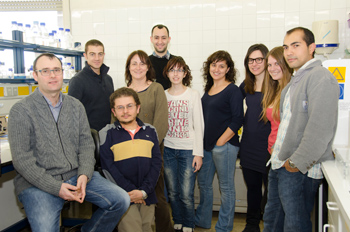New project underway to treat Fanconi's Anaemia with gene therapy

29/01/2013
Green light for the EUROFANCOLEN project to treat haematological problems in patients with Fanconi's Anaemia. This project aims to use gene therapy to correct the genetic defect in these patients' bone marrow stem cells. The project has got underway thanks to over ten years' work on preclinical and clinical research.
A European consortium has been set up involving experts on Fanconi's Anaemia and on gene therapy for other conditions. The clinical trials to be made will make use of new drugs to enable a large number of patients' haematopoietic stem cells to be collected (those in charge of forming blood cells).
The cells will then be exposed to lentiviral vectors, modified viruses that will carry the therapeutic gene, named FANCA, to assist in correcting the genetic defect of these stem cells for life. This therapy has already been used successfully by researchers from the consortium in patients with congenital immunodeficiencies or Beta-thalassemia. Since these new gene transfer vectors, of the lentivirus family, are displaying greater security and efficiency than previously-used vectors, they are being adopted in most clinical trials of gene therapy these days.
EUROFANCOLEN's new gene therapy means using two recent innovations in biotechnology. Firstly, the discovery of new powerful drugs to move stem cells from the bone marrow to the peripheral blood stream. Secondly, the development, by members of the consortium, which was approved in December 2010 by the European Commission, of a new lentiviral vector, as an orphan drug; this means that it affects a small percentage of the population, for patients with Fanconi's Anaemia.
The project's main objective is therefore to develop a safe and efficient gene therapy protocol for patients with Fanconi's Anaemia, subtype A, the most frequent, through a genetic correction of their haematopoietic stem cells, once these have been moved to the peripherical bloodstream.
The EUROFANCOLEN European Consortium was preceded by a Spanish initiative funded by the Ministry of Health, Social Services and Equality, for the treatment of Fanconi's Anaemia by gene therapy.
EUROFANCOLEN is coordinated by Juan A. Bueren, of the Centre for Research in Energy, Environment and Technology (CIEMAT) and CIBER for Rare Diseases (CIBERER), and includes Jordi Surrallés's research team from the Department of Genetics and Microbiology of the UAB. The following basic and clinical research teams are also taking part: Marina Cavazzana-Calvo, of Necker Hospital (France); Adrian Thrasher of University College London Institute of Child Health and Great Ormond Street Hospital NHS Trust (United Kingdom); Julián Sevilla, of the Hospital Infantil Universitario Niño Jesús; Cristina Díaz de Heredia, of the Hospital Vall d’Hebron; Anne Galy, of GENETHON (France); Jean Soulier, of Saint Louis Hospital and the University of Paris (France); Tobias Paprotka, of GATC Biotech AG (Germany); Manfred Schmidt, of the German Cancer Research Center. DKFZ/NCT (Germany); and Mario Romero, of IDETRA.
The project's scientific advisers are Eliane Gluckman, of the Saint Louis Hospital in Paris, who made the first umbilical cord blood transplant, precisely in a Fanconi's Anaemia patient, and Jakub Tolar, of the Fanconi's Anaemia Research Foundation (FARF) and the Children’s Hospital of Minnesota, one of the hospitals with most experience in treating this disease.
Fanconi's Anaemia
Fanconi's Anaemia is a serious hereditary disease characterised by bone marrow failure, increased risk of cancer and congenital anomalies. Allogeneic transplants (those from other persons) of haematopoietic stem cells are presently the only definitive treatment for the disease's haematological effects, though this often leads to complications deriving from immunosuppression and myelosuppression (reduction of bone marrow activity), from the so-called graft-versus-host disease (rejection of the receiver's cells) and a long-term increase in squamous cell carcinoma, a type of epithelial cancer.
Difficulties in obtaining sufficient stem cells from Fanconi's Anaemia patients and the use of inefficient protocols for transferring DNA (suboptimal transduction protocols) have until now limited the success of gene therapy clinical trials in patients with the disease.